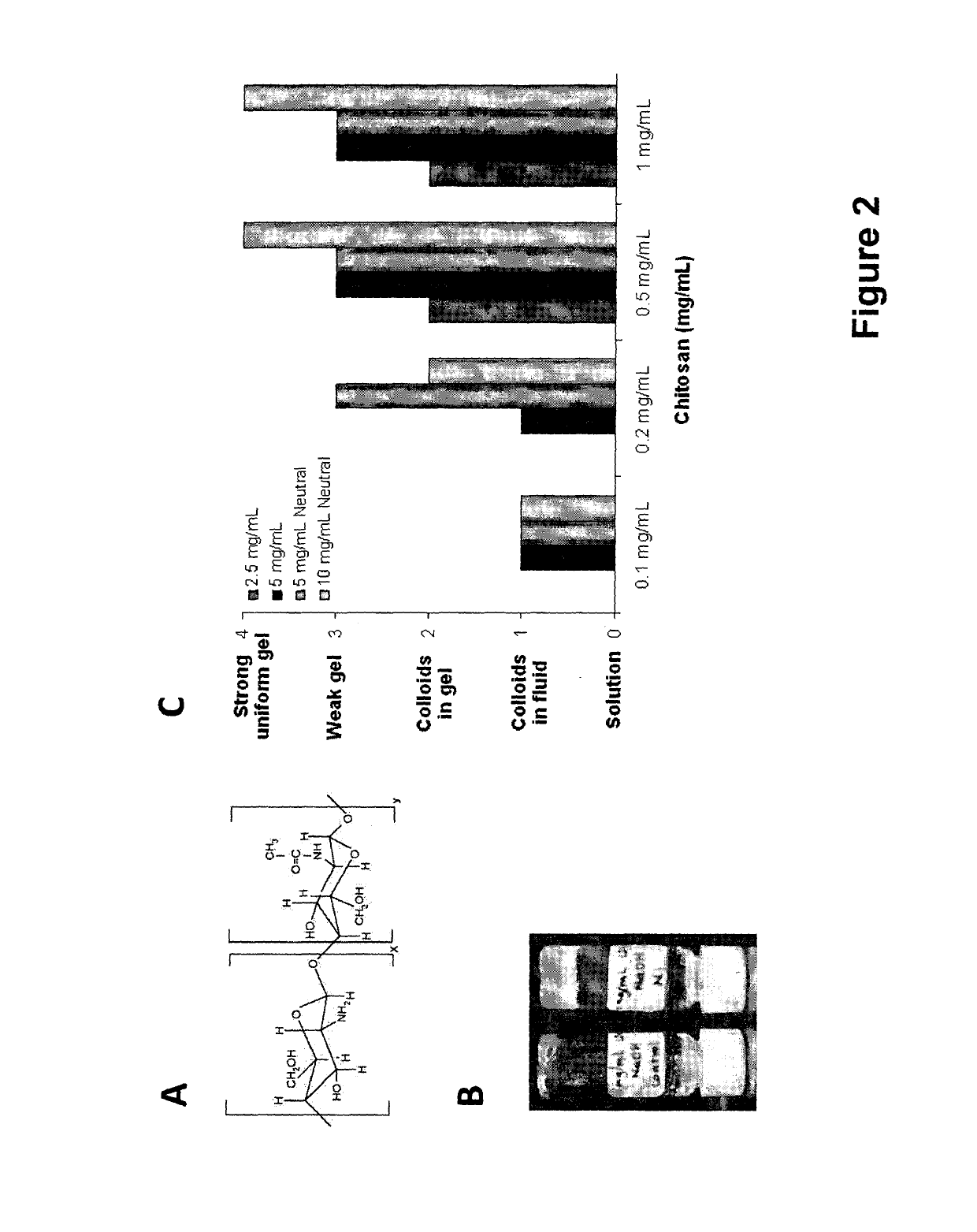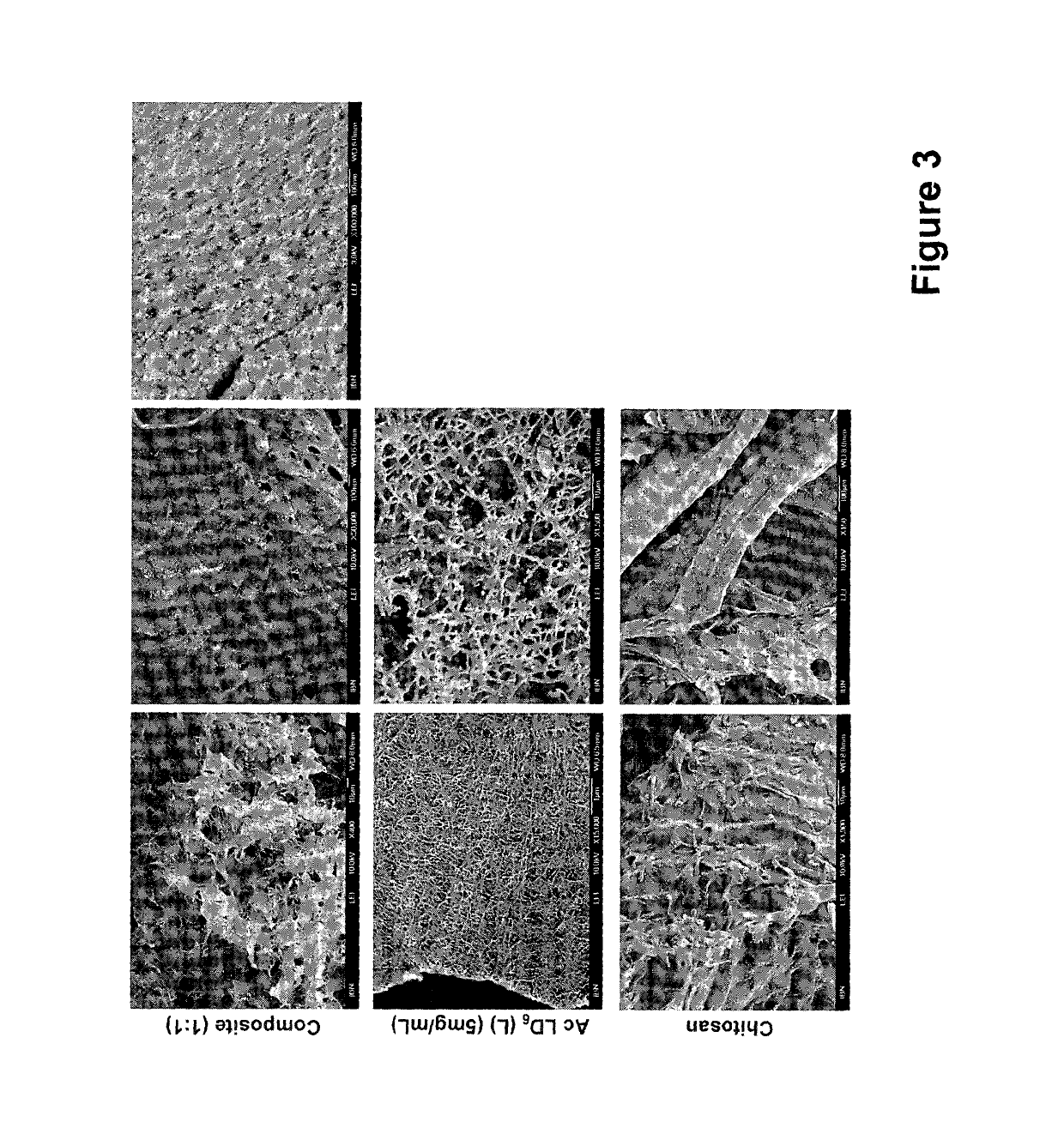Self-assembled composite ultrasmall peptide-polymer hydrogels
a polymer hydrogel and composite technology, applied in the direction of tripeptide ingredients, tetrapeptide ingredients, pharmaceutical non-active ingredients, etc., can solve the problems of affecting the treatment effect of stem cells, affecting the survival rate of surgery, and requiring feeder layers or coatings, so as to reduce the risk of surgery death, prevent the use of enzymes, and maintain the sternness and proliferation of stem cells.
- Summary
- Abstract
- Description
- Claims
- Application Information
AI Technical Summary
Benefits of technology
Problems solved by technology
Method used
Image
Examples
example 1
Ultrasmall Peptide-cationic Polymer Composite Hydrogels
[0229]Ultrasmall peptides with an acidic polar head group, such as AcLD6 (L) (i.e. Ac-LIVAGD; SEQ ID NO: 65), AcAD6 (L) (i.e. Ac-AIVAGD; SEQ ID NO: 76) and AcID3 (L) (i.e. Ac-IVD; SEQ ID NO: 72) form particularly stable composite hydrogels when mixed with (linear and branched) cationic polymers, such as chitosan and poly(amido amine) dendrimers (see Example 2 for more information). Gel formation is observed at higher pH compared to peptide only hydrogels. The stability of these composite hydrogels, as determined by their mass loss, in high salt conditions is also significantly improved. This observation suggests that the cationic polymers stabilize the hydrogels.
1. Formulation
[0230]As a proof of concept, the linear cationic polymer chitosan is used to demonstrate the feasibility of forming composite hydrogels with ultrasmall peptide AcLD6 (L) (i.e. Ac-LIVAGD; SEQ ID NO: 65). The formation of the composite hydrogel depends on man...
example 2
Ultrasmall Peptide-functionalized Polymer Composite Hydrogels Incorporating Branched Polymers
[0237]Branched polymers can also be used to formulate stable composite hydrogels when mixed with different ultrasmall peptides. In particular, synthetic, functionalized water-soluble polymers such as dendrimers offer unique properties and advantages with respect to functional group variation, molecular weights, polarity, and structural diversity. The possibility of adding different functional end groups, such as amines, carboxylic acids, thiols, alcohols, and carbohydrates offer attractive material and chemical properties, as well as conjugation strategies to immobilize bioactive molecules. The number of functional groups can easily be adjusted, and therefore the concentration of the therapeutic molecules of interest within the gel can also easily be modified and fine-tuned.
[0238]Dendrimers belong to a large class of molecules with discrete structural diversities, characterized by the specif...
example 3
Ultrasmall Peptide-neutral Polymer Composite Hydrogels
[0239]Ultrasmall peptides with various (acidic, basic, neutral) polar head groups formed stable composite hydrogels when mixed with uncharged polymers such as polyethylene glycol (PEG).
1. Formulation
[0240]As a proof-of-concept, di(ethylene glycol)diacrylate (DEGDA) forms composite hydrogels with ultrasmall peptides AcAS6 (L) (i.e. Ac-AIVAGS; SEQ ID NO: 69), AcLS6 (L) (i.e. Ac-LIVAGS; SEQ ID NO: 67), AcLT6 (L) (i.e. Ac-LIVAGT; SEQ ID NO: 68), and AcLD6 (L) (i.e. Ac-LIVAGD; SEQ ID NO: 65). The formation of these composite hydrogels depends on peptide concentration, PEG concentration and molecular weight, and the presence of other solvents.
[0241]Photoinitiators such as Irgacure 2959 and 369 (from BASF) can be incorporated into the composite AcAS6-DEGDA (i.e. Ac-AIVAGS; SEQ ID NO: 69), hydrogels (FIG. 6). Following UV irradiation, the gels change in appearance from clear / translucent to opaque.
[0242]The mechanical properties of the Ac...
PUM
| Property | Measurement | Unit |
|---|---|---|
| molecular weight | aaaaa | aaaaa |
| hydrophobicity | aaaaa | aaaaa |
| hydrophilic | aaaaa | aaaaa |
Abstract
Description
Claims
Application Information
 Login to View More
Login to View More - R&D
- Intellectual Property
- Life Sciences
- Materials
- Tech Scout
- Unparalleled Data Quality
- Higher Quality Content
- 60% Fewer Hallucinations
Browse by: Latest US Patents, China's latest patents, Technical Efficacy Thesaurus, Application Domain, Technology Topic, Popular Technical Reports.
© 2025 PatSnap. All rights reserved.Legal|Privacy policy|Modern Slavery Act Transparency Statement|Sitemap|About US| Contact US: help@patsnap.com



